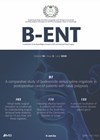
Journal Reviews
Surgery safety checklists
The time-outs were based on pre-flight checklists adopted by airline pilots and were instituted in all accredited hospitals and ambulatory care centres in the United States in 2003. The guidelines originate from general surgery and are not specific for the...
Is there a limitation for excising parapharyngeal tumours transorally?
The parapharyngeal space is a complex anatomical space bounded medially by the oropharynx and laterally by the mandible. It is conceptualised as an inverted pyramid extending from base of skull above to the hyoid bone below. The space is divided...
Which factors affect the postoperative CSF leak following endoscopic skull base surgery?
Endoscopic skull base surgery is being increasingly performed worldwide for skull base tumours. Common indications include pituitary tumours, rathke cleft cysts, chordomas, craniopharyngiomas and olfactory neuroblastomas. The most common and important complication following endoscopic skull base surgery is postoperative CSF...
Management of postoperative cholesteatoma
This prospective longitudinal observational study compared the ability of second-look surgery with that of surveillance using serial non-echo-planar diffusion-weighted imaging to detect residual cholesteatoma after canal wall-up mastoidectomy. A total of 34 patients were included in the study who underwent...
Lateral skull base surgery using the endoscope
Endoscopic lateral skull base surgery could be performed via less invasive techniques due to wide panoramic visualisation of the operative field. With less invasive techniques, patients have been shown to require shorter recovery time and reduced postoperative pain. In this...
Reducing the risk of Frey’s syndrome after parotidectomy – which methods are best?
Gustatory sweating or Frey’s syndrome is a well-recognised complication of parotid surgery. The reported incidence is highly variable, from 4% to 96%, with around 30% of patients reporting symptoms. A number of intraoperative techniques can be used to reduce the...
Structures determining T4a, T4b
This paper for tertiary cancer centre in India attempted to determine whether patients with T4b oral cancers involving the 'masticator space' should be treated with survival intent comparable to T4a cancers. Over a 7-year period, 30 patients with T4b cancers...
Simple preoperative tests predicting outcomes for ESS patients?
We are all familiar with patients suffering extensive nasal polyps who relapse all to soon after careful and thorough endoscopic sinus surgery (ESS). This paper looks to answer whether we can predict which patients will do well, and which less...
Efficacy of stereotactic radiosurgery for facial nerve schwannoma
This international multicentre study reviewed the results of stereotactic radiosurgery (SRS) in 63 patients with facial nerve schwannoma over three decades. The facial nerve schwannoma were distinguished from vestibular schwannoma based on intraoperative findings or typical temporal or extra temporal...
Narrow band imaging in the management of carcinoma of unknown primary
This was a retrospective study to assess the utility of narrow band imaging (NBI) in the detection of a primary site in carcinoma of unknown primary (CUP). Patients with CUP who underwent transoral robotic surgery (TORS) and preoperative imaging with...
The medially-invasive cholesteatoma: a case series
In this small case series, Casazza et al describe their management of seven cases of complex cholesteatoma presenting during a 16-year period. Patients were included if imaging confirmed restricted diffusion and an endophytic, medially-destructive disease involving the otic capsule, petrous...
Endoscopic stapes surgery - pearls and pitfalls
Endoscopic ear surgery has gained popularity in recent years with wide panoramic visualisation of the operative field one of its key strengths. This article summarises the approach, set-up and outcomes of patients undergoing endoscopic stapes surgery. A key step during...
















